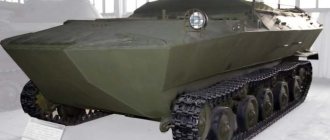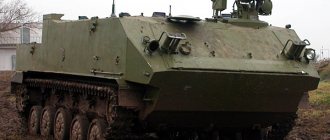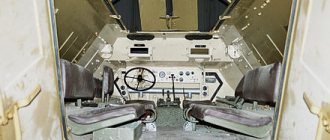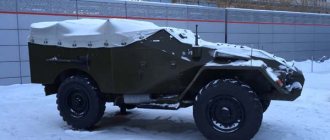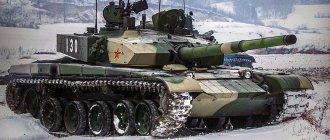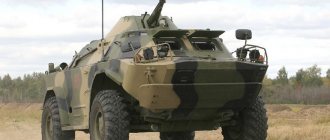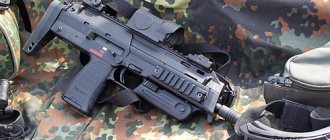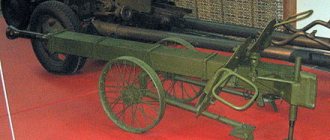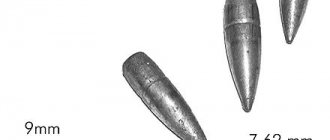History of creation[edit]
The development of a 120-mm self-propelled mortar based on the BTR-3 became known in 2011. Placing a mortar on the platform of an armored personnel carrier can significantly increase its effectiveness and the combat power of artillery units; such equipment can easily follow motorized infantry units and provide them with fire support exactly at the time when it is needed. The weapon chosen was a powerful 120-mm mortar, which has a wide range of ammunition, including domestic developments in the form of a high-precision laser-guided projectile.
In November 2013, the first BTR-3M2 was presented at the training ground and fired live mines.
July 26, 2014 at the training ground at the training center of the National Guard of Ukraine in the village. New Petrovtsy new models of weapons and equipment planned for delivery to NSU were presented. Among the presented samples was one BTR-3M2.
In August 2014, General Director of the State Concern “Ukroboronprom” R.A. Romanov said in an interview that the concern has two self-propelled mortars BTR-3M2, which can be transferred to the Ministry of Defense of Ukraine for state testing or sent directly to the troops. He also stated that the transfer of the BTR-3M2 for state testing is one of the stages of fulfilling the order of the President of Ukraine to provide the Armed Forces and the National Guard with new types of weapons.
Modifications
BTR-3E1 at the Africa Aerospace and Defense Expo 2010
BTR-3E as a participant in the external exhibition of military equipment at the National Museum of the History of Ukraine in the Second World War. Kyiv, July 2020.
- BTR-3U "Guardian"
- a deep modification
of the BTR-94K
, with a Deutz BF6M1015 engine and an Allison MD3066 automatic transmission, or a UTD-20 engine. Equipped with the KBA-105 Shkval combat module.[18] - BTR-3U1
- BTR-3U with a BM-3S combat module armed with a ZTM-1 automatic cannon and a 7.62 mm PKT machine gun. - BTR-3E
- with UTD-20 or Deutz BF6M1015 engine.
Equipped with the BM-3M “Sturm-M” combat module.[1] BTR-3E1
- BTR-3E, in which the Tandem fire control system was replaced by the TREK fire control system[10] - BTR-3E with a CSE 90LP turret
manufactured by the Belgian company CMI Defense - a demonstration sample was shown in February 2013 at IDEX-2013[24] - BTR-3E CPWS-30
- modification of 2014 with the Belgian CPWS-30 combat module [25] - BTR-3EU1
is a modification of the BTR-3E, developed in 2020 and approved for use in the armed forces of Ukraine in 2020[26]
- command vehicle
- armored medical vehicle
is an ARV equipped with hooks, winches and a bulldozer blade.
is a self-propelled anti-tank system armed with 4 Barrier ATGM launchers (ammunition load - 16 missiles)[27] and a 12.7-mm NSVT machine gun[28]
- self-propelled mortar, armed with an 81/82 mm mortar and a 12.7 mm NSVT machine gun
is a self-propelled mortar armed with a 120 mm mortar and a 12.7 mm NSVT machine gun[10]
— modification of 2020[29], with a maximum speed increased to 104 km/h and improved protection, weighing 16.5 tons. Adopted by the Ukrainian Armed Forces in November 2015[30]
- BTR-3DA/70
- A version of the BTR-3DA with an armored hull made using the lower part of the BTR-70. In the period from 10/19/2015 to 10/23/2015, both samples of BTR-3DA and BTR-3DA/70 successfully passed departmental tests.[31]
Design description[edit]
Hull and armor[edit]
The hull armor is bulletproof and anti-fragmentation. Type of armor - rolled homogeneous steel. Inner ball made of Kevlar type material. The crew of the BTR-3M2 consists of four people: the vehicle commander, driver, gunner and loader.
Weapons[edit]
The armament of the BTR-3M2 includes:
- 120-mm mortar with optical-mechanical sight (ammunition - 40 mines, stacked horizontally in racks on the left and right sides). The mortar base plate is attached to the outside of the body (which allows the mortar to be used separately from the armored vehicle).
- 12.7 mm NSVT machine gun with a K-10T collimator sight (300 rounds of ammunition) - openly mounted in the front of the armored vehicle.
- device for shooting 81-mm smoke grenades (six smoke grenades ammunition).
The artillery part of the mortar was developed by the state enterprise Design Bureau “Artillery Armament” (SE KBAO).
The BTR-3M2 is equipped with a radio station.
Engine and transmission[edit]
The power plant is an in-line, 6-cylinder, liquid-cooled turbocharged diesel Mercedes MTU6R106TD21 with a power of 325 hp. Transmission 6-speed, hydromechanical Allison 3200SP.
Chassis[edit]
Wheel formula 8x8. Individual torsion bar suspension with hydraulic shock absorbers.
Amphibious armored personnel carrier AAAV (EFV) (USA)
By the mid-90s, the US Marine Corps was armed with about 2,400 LVTP7 armored personnel carriers of various modifications and 735 LAV-25 wheeled armored personnel carriers. Amphibious armored personnel carriers are used mainly for landing marines from landing ships on the coast, seizing a bridgehead and developing success in the depths of enemy defenses. They must have a high speed of movement afloat, reducing their vulnerability to enemy fire and allowing amphibious assault to be delivered to the shore in a short time to successfully complete their assigned tasks. For armored personnel carriers currently in service, the afloat speed no longer meets modern requirements. Thus, LVTP7A1 develops a speed of about 13.5 km/h on water, LAV-25 - 10 km/h and M113A3 - 5.6 km/h. That is why, when developing new armored personnel carriers, an indispensable condition was set - they must have greater autonomy, be highly maneuverable and high-speed in two environments - on land and water. Back in 1989, the command of the Marine Corps formulated the basic tactical and technical requirements for a promising armored personnel carrier, which were based on preliminary tests of various models and the desire to optimally use engine power, and also took into account the possibilities of new technologies and financing: • combat weight - 32,886 tons. • capacity — 21 people (including 3 crew members); • duration of operation on land - 85%, • caliber of the main armament - 25-30 mm, • increase in armor protection compared to the LVTP7A1 armored personnel carrier - 200%, • maneuverability on water - 360", • speed of movement, afloat - 37-46 km/h, maximum on the highway - 73 km/h, average over rough terrain - 48 km/h • range on land - 480 km. • the design and equipment of the armored personnel carrier must ensure combat and hitting the target on the move, day or night, • it is necessary to have a system for creating favorable conditions for the crew and troops in various climatic conditions; a reliable communication system between the armored personnel carrier and the command and control vehicle, a communication system common to the marine corps and ground forces; a filter-ventilation unit, mine protection, thermal smoke equipment and an active protection system, • the armored personnel carrier must have the reliability and maintainability at the level of a modern main battle tank
The US Army's need for such vehicles gave impetus to the development of the AAAV ( Advanced Amphibious Assault Vehicle ) armored personnel carrier to replace the obsolete LVTP7A1. Its design is based on the results of AAI's developments obtained during the construction of HWSTD and PSD prototypes using computer modeling of various systems.
HWSTD was designed back in 1989. Its mass is 16.2 tons. Two water-jet propulsors provide a design speed afloat of 28 knots (52 km/h), PSD with a mass of 26.4 tons developed a speed of almost 30 knots (about 56 km/h) in the water due to a block of four water-jet propulsors with a diameter of 406 mm. mounted on a folding ramp in the aft part of the hull, and a special bottom covering. Other prototypes were the HTR experimental hydrodynamic machine and the GDLS machine. The American company General Dynamics Land Systems took on the development of the AAAV project.
One of the problems that arose when creating the AAAV armored personnel carrier was the shape and contours of the hull, which could provide speed afloat up to 25 knots (46 km/h) and high maneuverability on land. As a result, an elongated hull shape with a curved trough-shaped bottom was chosen. Folding ramps and bulwarks serve as a hydrofoil, and the frontal folding sheet serves as a breakwater. Considerable attention was paid to reducing the weight of the machine, for which aluminum, titanium and composite materials were widely used in its instructions. The most effective research in this area was carried out by the American company UDLP, whose specialists over the past ten years have been studying the possibility of using armor on AAAVs using ceramic materials.
A total of nine prototypes of the vehicle were created, of which six were intended for testing on water and three on land. Based on them, it was planned to develop two basic options: the AAAV(P) armored personnel carrier and the AAAV(C) command and staff vehicle.
It is planned to install an active protection system on the AAAV armored personnel carrier. Its sensors, connected to an on-board computer developed using artificial intelligence technology, are capable of detecting the moment an enemy ATGM is launched and sending an appropriate signal to counteract it, for example, activating a laser or infrared jamming station, which in the future can be combined with a missile that intercepts an approaching ATGM. It is planned to install a 25-mm automatic cannon on the armored personnel carrier as the main weapon, a 7.62-mm machine gun as an auxiliary weapon, and smoke grenade launchers as an additional weapon.
Serious attention is paid to the radio-electronic equipment of the AAAV. It is planned to install a new control, communications and reconnaissance system capable of automating the battle control process on both linear and command post vehicles. The armored personnel carrier should serve both as a means of delivering marines from a landing ship to the shore, and as a mobile command post, allowing the commander of a unit (unit) to have stable radio communications over long distances with higher command and subordinate units, as well as with supporting and supply forces and means. In-vehicle communications will be provided using the new VIICS communications system. In addition, it is planned to equip it with a NATO navigation system and test a new generation tactical command and control system developed by Loral.
It is planned to use a turbocharged diesel engine with a power of 1656 kW from MTU as the power plant. An armored personnel carrier with a combat weight of about 32.9 tons will allow it to reach speeds of up to 46 km/h while afloat. Rotary and diesel engines from other companies are also being considered as possible options. It is envisaged that while afloat the torque is simultaneously transmitted to the water jets and to the tracks.
It is expected to increase the speed of movement of vehicles afloat, in particular, by combining several water jets into retractable (reclining into the water) container blocks with an electric or hydraulic drive, using remote (from the hull) water jets, changing the geometry of the propeller, the shape and material of the hull and inlet water devices.
The contract for the production of AAAV will be concluded after the selection of the main contractor, and the start of mass production was planned for 2007. The estimated total order volume was about 1,400 vehicles. After 2003, the AAAV project changed its name to EFV ( Expeditionary Fighting Vehicle ). AAAVs were originally expected to enter service in the mid-1990s, but delays in the program led to a second AAV life extension program being developed and adopted in 1995, and EFV delivery delays have now been more than 15 years. At the moment, the US Marine Corps is awaiting the start of serial production of the EFV and the supply of armored personnel carriers to the troops (there is also evidence that they will arrive only in 2020), where they will gradually replace the AAV7A1. It was originally planned to purchase 1013 EFVs, but this number has now been reduced to 557 due to the increased cost of the program.
the EFV prototypes is as follows: The EFV is a tracked amphibious armored personnel carrier, with a hull made primarily of aluminum. The shape of the hull is classic, with straight sides, a developed NLD and a rear wall with a slight negative slope. The hull roof is flat, with a turret mounted closer to the front, a landing hatch in the rear and crew hatches in the front. The bottom is profiled to ensure EFV planing. In addition to the aluminum hull, the fighting compartment and the troop compartment are protected by additional armor made of composite materials and ceramics. The armor must provide protection from 14.5 mm armor-piercing bullets and fragments of 155 mm shells. It is also possible to install mounted armor.
The front part of the hull is occupied by the transmission compartment, behind it there is a combat compartment, in which there are seats for the driver (on the left side) and the landing commander (on the right). The middle part of the fighting compartment is occupied by a turret with the main armament installed; the turret contains seats for the gunner and commander. The middle part of the hull is occupied by the power compartment, which houses the MTU 883 diesel engine, cooling and ventilation systems, and the main transmission. In the rear part of the hull there is a landing compartment with an internal volume of 9 m3, accommodating 16 paratroopers with weapons and equipment, or 2.5 tons of cargo. For the entry and exit of the landing force, an oval single-leaf hatch is equipped in the rear wall of the hull, which opens downwards and, when open, forms a small ramp for marines or cargo.
Fuel tanks are located on the roof of the hull in the middle part, along the sides.
Engine MTU 833 diesel, 12-cylinder, V-shaped, water-cooled, turbocharged. Engine capacity is 27 liters. A special feature of this engine is that it can operate in two modes, normal (850 hp) and marine (2701 hp). In the second case, the engine runs only on EFV water-jet propulsion and requires seawater cooling.
The transmission is mechanical, with an automatic gearbox and torque converters, the transfer case allows you to transfer engine power simultaneously to the tracked and water-jet propulsion.
The chassis has 7 rubber-coated road wheels on each side, the suspension is hydropneumatic, independent, front drive rollers, and 3 support rollers on each side. The caterpillar is small-linked, aluminum, with a rubber-metal hinge and a rubber tread. When moving on water, the suspension brings the track rollers to the highest position, to reduce movement resistance, while the tracks are almost completely retracted into the niches.
Two water-jet propulsors are located on the sides at the rear of the hull; water is taken from below in the middle part of the hull and discharged through nozzles on the rear wall of the hull. The nozzles are equipped with flaps, when closed, water enters the reversible nozzles on the side of the body. The course control is carried out by partially or completely closing one damper, and reverse - by closing two. When moving on land, the flaps completely block the nozzles of the water cannons, protecting them from the ingress of foreign objects. The total thrust of water-jet propulsion is about 10 tons.
When moving through the water, two shields fold down at the front and rear, making it easier for the EFV to enter planing mode. The rear shield in the raised position is located on the roof. When moving on water, the side parts of the tracks are covered with two folding side shields; when moving on land, the shields can be raised and serve as additional protection for the hull.
The EFV's main armament is a 30mm Bushmaster II autocannon mounted in a rotating turret at the front of the hull. The gun is a 30mm version of the 25mm Bushmaster gun found in the American M2 Bradley infantry fighting vehicle. Belt feeding, gun ammunition 600 shells (150 sub-caliber armor-piercing and 450 high-explosive). The cannon is paired with a 7.62 mm M240 machine gun, the machine gun's ammunition capacity is 2,400 rounds. There are 32 smoke grenade launchers installed on both sides of the hull and turret. The gun is stabilized in both planes. The gun's elevation angle allows it to fire at low-flying air targets such as helicopters.
The EFV amphibious armored personnel carrier has a fairly wide range of surveillance, sighting, navigation and auxiliary equipment, including: Day and night sights for the commander, driver and gunner Infrared surveillance system FLIR Laser range finder combined with a gunner's sight. Fully automatic control system for the main gun, taking into account parameters such as range to the target, type of projectile, wind direction, air temperature, humidity, and elevation angle. Navigation system with GPS. Internal and external communication system. Combat information and control system, including several overview and tactical screens. Automatic fire extinguishing system. A system of protection against weapons of mass destruction, including a cleaning and air conditioning system. Diesel auxiliary power unit (APU) with an electric generator. The command version of the EFVC is distinguished by the fact that in its combat and landing compartment additional equipment is installed with 7 workstations equipped with communication systems and tactical displays. The command version does not have main weapons.
Weight, kg: 34.473 kg. Armor: ceramic/composite Engine type and model: Diesel MTU MT 883 Ka-523 Speed, km/h: 72.41 km/h (highway), 46 km/h (on water) Specific power, hp/t: 34.48 hp/ton Engine power, hp: 2702 hp (on water), 850 hp (on land) Cruising range, km: 523 km (on land), 120 km (on water) Suspension: Hydropneumatic Main armament: 1 x 30 mm MK44 Bushmaster II cannon Secondary armament: 1 x 7.62 mm M240 machine gun Length, mm : 10.67 m. 9.33 m. Width, mm: 3.66 m. Height, mm: 3.28 m. (tower roof) Crew (crew): 3+17
Combat use
From October 2003 to 2011 it was used in operations in Iraq. The United States did not publish the losses of “strikers” during the war. It is known that during the first week of the battle for Baqubah in May 2007, 5 vehicles were destroyed, 8 people were killed and several dozen were wounded.[8]
From 2009 to 2011 it was used during the war in Afghanistan. The “striker” crews suffered the heaviest losses among all other units [ source not specified 768 days
].
In the first year of use alone, the mechanized brigade armed with “strikers” lost 275 servicemen killed and wounded. The US vehicle losses were not published [ not in the source
]. Losses for three years are unknown.[9]
